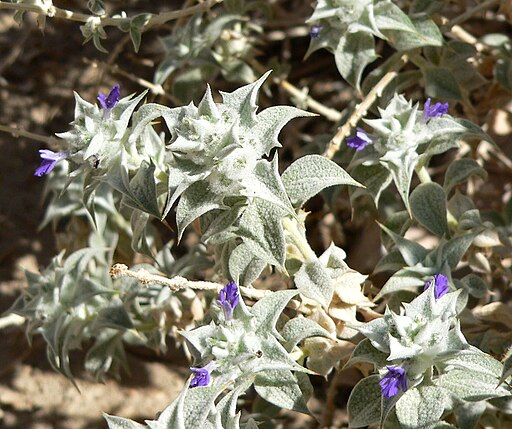Classification System: APG IV
Superregnum: Eukaryota
Regnum: Plantae
Cladus: Angiosperms
Cladus: Eudicots
Cladus: Core eudicots
Cladus: Asterids
Cladus: Lamiids
Ordo: Lamiales
Familia: Lamiaceae
Subfamilia: Nepetoideae
Tribus: Mentheae
Subtribus: Salviinae
Genus: Salvia
Subgenus: S. subg. Sclarea
Sectio: S. sect. Echinosphace
Species: Salvia funerea
Name
Salvia funerea M.E.Jones, Contr. W. Bot. 12: 71. 1908.
Synonyms
Homotypic
Salvia funerea var. typica Munz, Bull. S. Calif. Acad. Sci. 26: 20 (1927), not validly publ.
Heterotypic
Salvia funerea var. fornacis Jeps., Man. Fl. Pl. Calif.: 868 (1925).
Distribution
Native distribution areas:
Continental: Northern America
Regional: Southwestern USA
SE. California, Nevada.
References: Brummitt, R.K. 2001. TDWG – World Geographical Scheme for Recording Plant Distributions, 2nd Edition
References
Primary references
Jones, M.E. 1908. Contributions to Western Botany, No. 12. BHL Reference page. : 12: 71
Additional references
Govaerts, R.H.A. 2003. World Checklist of Selected Plant Families Database in ACCESS: 1-216203. The Board of Trustees of the Royal Botanic Gardens, Kew. [unavailable for the public] Reference page.
Links
Govaerts, R. et al. 2022. Salvia funerea in World Checklist of Selected Plant Families. The Board of Trustees of the Royal Botanic Gardens, Kew. Published online. Accessed: 2022 May 10. Reference page.
Hassler, M. 2022. Salvia funerea. World Plants: Synonymic Checklists of the Vascular Plants of the World In: Roskovh, Y., Abucay, L., Orrell, T., Nicolson, D., Bailly, N., Kirk, P., Bourgoin, T., DeWalt, R.E., Decock, W., De Wever, A., Nieukerken, E. van, Zarucchi, J. & Penev, L., eds. 2022. Species 2000 & ITIS Catalogue of Life. Published online. Accessed: 2022 May 10. Reference page.
Tropicos.org 2022. Salvia funerea. Missouri Botanical Garden. Published online. Accessed: 10 May 2022.
International Plant Names Index. 2022. Salvia funerea. Published online. Accessed: May 10 2022.
Vernacular names
English: Death Valley sage, woolly sage, funeral sage
Salvia funerea, is a species of semi-deciduous perennial shrub with the common names Death Valley sage, woolly sage, and funeral sage, is an intricately branched shrub associated with limestone soils in the Mojave Desert in California and Nevada.[1] It is characterized by an overall white appearance due to wooly hairs that cover the stems and leaves.[1]
Description
Salvia funerea is a shrub that may exceed a meter in height. It is densely branched, and the branches are densely covered in white, wooly hairs. The leaves are 9 to 20 mm long, have short petioles, and are generally deciduous. The leaf blade is shaped more or less ovate, with spines at the tip and sometimes on the margins.[2]
There are generally 3 flowers emerging in the axils of the sharply-toothed leaves. The flowers have a calyx 4.5 to 6 mm large, with 5 lobes that are shaped triangular, and tipped with spines. The corolla tube is 12 to 16 mm long, colored violet, with the stamens and style included (not projecting beyond the mouth of the corolla).[2][3]
Taxonomy
This species was described in 1908 by Marcus E. Jones based on a specimen collected in Inyo County, California.[3] The specific epithet, "funerea", relates to where the plant was first found, in the Funeral Mountains along the California-Nevada border. It is closely related to Salvia greatae.[4]
The chromosome number is 2n=64.[2]
Distribution
The plant can be found in dry alkaline washes with limestone soils and on the limestone cliffs of narrow canyons. It is distributed throughout the western slopes of the Amargosa Range (the Funeral Mountains, Black Mountains, and Granite Mountains), in Titus Canyon in the Grapevine Mountains, and in the northern Panamint Range in Grotto and Mosaic Canyons.[1][3] Most populations are within Death Valley National Park, in Inyo County, California and Nye County, Nevada.
This species is found in association with Creosote bush scrub (Larrea and Ambrosia), and is often found with Atriplex hymenelytra, Bahiopsis reticulata, Encelia farinosa or Encelia actoni, and Eucnide urens.[3]
Cultivation
This species is regarded as unsuitable for cultivation, due to its need of very restrictive habitat conditions, which are limestone cliffs or alkaline desert washes with limestone soils.[5]
References
Mojave Desert Wildflowers, Pam MacKay, 2nd ed., p 57
Averett, Deborah Engle (2012). "Salvia funerea". Jepson eFlora. Jepson Flora Project. Retrieved January 5, 2022.
Epling, Carl (February 1938). "The Californian Salvas. A Review of Salvia, Section Audibertia". Annals of the Missouri Botanical Garden. 25 (1): 95–188. doi:10.2307/2394478. JSTOR 2394478 – via JSTOR.
Jaeger, Edmund C. (1940). Desert Wild Flowers. Stanford University Press. ISBN 978-0-8047-0365-9.
Wilson, Bert (2012). "Salvia funerea, Death Valley Sage". Las Pilitas Nursery. Las Pilitas Horticultural Treatment. Retrieved January 5, 2022.
Mojave Desert Wildflowers, Jon Mark Stewart, 1998, pg. 183
Retrieved from "http://en.wikipedia.org/"
All text is available under the terms of the GNU Free Documentation License


